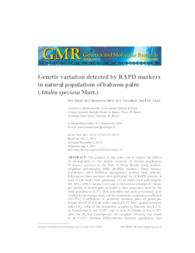Genetic variation detected by RAPD markers in natural populations of babassu palm (Attalea speciosa Mart.).
Genetic variation detected by RAPD markers in natural populations of babassu palm (Attalea speciosa Mart.).
Autoria: SANTOS, M. F.; SILVA, K. J. D. e; CARVALHAES, M. A.; LIMA, P. S. da C.
Resumo: The purpose of this study was to analyze the effects of management on the genetic structure of natural populations of Attalea speciosa in the State of Piauí, Brazil, using random-amplified polymorphic DNA (RAPD) markers. Three babassu populations under different management systems were selected. Polymerase chain reactions were performed for 20 RAPD primers. A total of 146 bands were generated, 141 of which were polymorphic (96.58%), with a variation of 4 and 12 loci and an average of 7 bands per primer. A dendrogram revealed a clear separation between the three populations (0.57). Data reliability and node consistency were verified by bootstrap values and the cophenetic correlation coefficient (88.15%). Coefficients of similarity between pairs of genotypes ranged from 0.26 to 0.86, with a mean of 0.57. Nei?s genetic diversity index (HE) value of the population sampled in Teresina was 0.212, of Esperantina it was 0.195, and of José de Freitas it was 0.207. After the HE was decomposed, the complete diversity was found to be 0.3213. Genetic differentiation between populations was0.362, and the estimation of gene flow between populations was low (0.879). Analysis of molecular variance revealed that 59.52% of the variation was contained within populations, and 40.48% was between populations. RAPD markers were effective for genetic diversity analysis within and between natural babassu populations, and exhibited a high level of polymorphism. Genetic diversity was the highest within populations; variability was lower in the managed populations than in the undisturbed populations.
Ano de publicação: 2015
Tipo de publicação: Artigo de periódico
Unidade: Embrapa Meio-Norte
Observações
1 - Por padrão são exibidas publicações dos últimos 20 anos. Para encontrar publicações mais antigas, configure o filtro ano de publicação, colocando o ano a partir do qual você deseja encontrar publicações. O filtro está na coluna da esquerda na busca acima.
2 - Para ler algumas publicações da Embrapa (apenas as que estão em formato ePub), é necessário ter, no celular ou computador, um desses softwares gratuitos. Sistemas Android: Google Play Livros; IOS: iBooks; Windows e Linux: software Calibre.
Acesse outras publicações
Acesse a Base de Dados da Pesquisa Agropecuária (BDPA) para consultar o acervo completo das bibliotecas da Embrapa.

